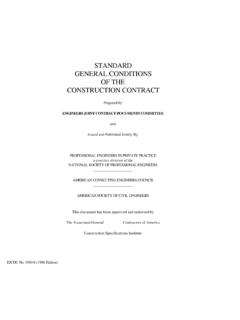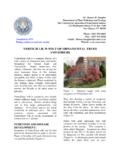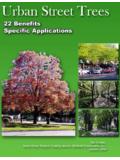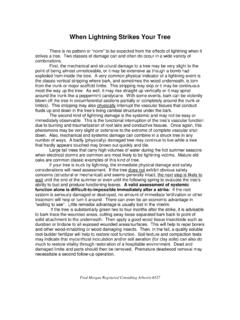Transcription of Preferred Trees for South Central Kansas
1 Preferred Trees for South Central Kansas Growing Trees successfully depends on the selection of the right Trees for the intended site. It is important to match the growing conditions and space available on the site with the cultural requirements and projected size of each tree to be planted. The following four charts show the tolerances of individual Trees to various environmental conditions as well as the major landscape attributes of each tree . Not all recommended Trees for planting in South Central Kansas are included.
2 The Preferred Trees listed were recommended by industry professionals such as city foresters, local tree boards, county and horticulture extension agents, commercial arborists and retail/production nursery interests. KEY TO USING THIS INFORMATION: tree SPECIES AND CULTIVARS: The names of the Trees are listed in the center of four different charts. Three of the charts list deciduous Trees according to average mature height [a plus (+) indicates they may grow slightly larger.] The fourth chart lists evergreen Trees .
3 If improved cultivars of the Trees are available and recommended, they are listed. Cultivars often possess improved plant characteristics like better fall color; a unique form; more attractive flowers, fruit or bark; greater heat tolerance; or increased pest resistance. Many Trees are available in single and multi-stemmed form. Multi-stemmed forms are more likely to be damaged from snow, ice, or wind. ENVIRONMENTAL TOLERANCES: The left side of each chart indicates whether the tree is tolerant to various environmental conditions including full sun, light shade, alkaline soil, drought or wet soil.
4 Each chart also shows how resistant each tree is to insect and disease pests. A G (for good) under the appropriate column indicates the tree is strongly tolerant of the characteristic indicated. A F (for fair) signifies that the tree shows some tolerance. A blank space in a column indicates the tree is not tolerant and should not be subjected to that environmental condition. Specific information on the alkaline soil and pests categories follows: ALKALINE SOIL: (G) = tree may tolerate soils with a pH up to or more; (F) = tree generally will tolerate an alkaline soil up to a pH of ; (blank) = tree may not tolerate alkaline soils; do not plant in alkaline soils to avoid the problem of iron or manganese chlorosis.
5 PESTS: (G) = tree is usually free of insect and disease problems; (F) = tree encounters insect or disease pests on an infrequent basis and often is not permanently damaged; (blank) = tree may suffer from pests which may permanently damage or kill the tree and/or the tree may exhibit minor insect and disease problems on a frequent basis which may affect the aesthetics of the tree or insects may commonly be a nuisance. LANDSCAPE ATTRIBUTES: The right side of each chart includes average mature height and spread of each tree .
6 The size is sometimes highly variable due to the size and shape of different cultivars planted and variability among growing sites. The landscape attributes of flowers, fruit, autumn color and ornamental bark are also listed. DESIRABLE FLOWERS: (G) = the flowers are showy, adding unique ornamental interest to the landscape; (F) = the flowers are not particularly showy, but may possess other desirable characteristics such as fragrance; (blank) = the flowers are generally considered insignificant. SHOWY OR USEFUL FRUIT: (G) = fruits are generally aesthetically pleasing; (F) = fruits or nuts are not considered unusually showy, but may provide other interest or benefits such as attracting wildlife; (blank) = no showy or useful fruit.
7 AUTUMN FOLIAGE COLOR: (G) = the autumn leaf color is typically quite good (may vary with individual Trees , cultivars and environmental conditions, however); (F) = the fall color may provide interest in some years; (blank) = autumn foliage color is generally not considered an asset of this particular tree . ORNAMENTAL BARK: (G) = the bark or twigs are considered to be exceptionally ornamental; (F) = the bark or twigs (on at least some cultivars) lend interest to the landscape (good color, texture, etc.); (blank) = the bark or twigs are not generally considered to be ornamental.
8 This publication is made available in cooperation with the USDA Forest Service. Kansas State University and the Kansas Forest Service is committed to making their services, activities and programs accessible to all participants. Support and input for this publication is provided by: ENVIRONMENT (tolerant of) LANDSCAPE ATTRIBUTES FULL SUN LIGHT SHADE ALKALINE SOIL (HIGH pH) DROUGHT WET SOIL PESTS (RESISTANT TO) SMALL DECIDUOUS Trees (usually under 20 feet at maturity) Trees with mature height 20 feet or less can be used within 15 feet on either side of utility lines.
9 MATURE HEIGHT MATURE SPREAD DESIRABLE FLOWERS SHOWY OR USEFUL FRUIT AUTUMN FOLIAGE COLOR ORNAMENTA L BARK G F F G F F Amur Maple (Acer ginnala) Cultivars: 'Compactum' (reduced size); 'Flame' 15-20 15-25 F F G G F G G F Tatarian Maple (Acer tataricum). 20-25 15-25 F F F G G F F Eastern Redbud (Cercis canadensis) Cultivars:also available: (white flowers) 20-25+ 20-25+ G F F G F G F F Oklahoma Redbud (Cercis canadensis subsp.)
10 Texensis 'Oklahoma') (glossy green leaves, more intense flower color, insect resistance) 15-20+ 15-20+ G F F G F G G Winterberry Euonymus (Euonymus bungeanus) 15-20+ 10 G F G F F F Flowering Crabapple (Malus spp.) For disease resistant cultivars see Crabapple publication. varies varies G G F








